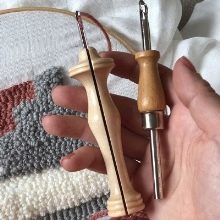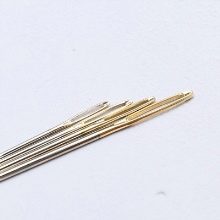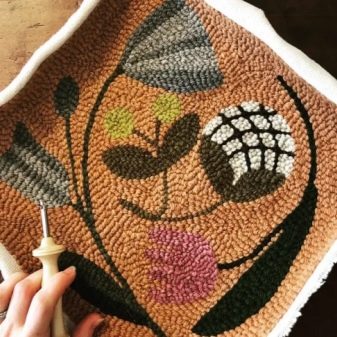The history of tapestries dates back more than 8 centuries. In ancient times, tapestries were created using the weaving technique of woolen and silk threads. Woven fabrics adorned the walls of the dwellings. Modern tapestries are created both in the weaving technique and in the way of embroidering with tapestry needles on dense fabric.


Description
Needle for tapestry embroidery is designed to create do-it-yourself tapestries of various kinds. Tapestry needles are made of carbon steel. For smoothness, the coating is made of nickel. From past centuries, the method of gold sewing has been preserved. Then the embroideries were embroidered with gold or platinum needles. These needles were particularly smooth and easy to use. Currently, some manufacturers carry gold-plated metal needle ears. Contrast color serves as a marker for convenience when threading.
Tapestry embroidery needles differ from the rest in that they are blunt, with a rounded tip. Thickness gradually increases from the tip to the thread hole. The oval-shaped eyelet is convenient for free movement of the thread. For each type of embroidery, a needle is selected in accordance with the density of the fabric and the type of work performed. Thin needles with a small eye, even along almost the entire length, are used for embroidery in the Rococo style. Crosses in the style of “petit” are embroidered with short, thin needles.
To embroider satin, sharp, thin needles with a small eye are suitable.


To create a tapestry, a dense fabric with holes for the needle is selected. This rigid canvas stramin resembles a sieve. Needlework stores sell printed stramin. It is very convenient to embroider with a tapestry seam according to the pattern, using woolen, acrylic threads or floss.The canvas for embroidery is divided into squares with holes for free passage of the needle. When making a half-cross, the needle from the wrong side is inserted into the lower left edge of the square and on the front side comes into the upper right corner. So the row is embroidered from left to right.
When the next back row is performed, the needle from the upper right corner pulls the thread to the lower left corner. On the wrong side, straight vertical stripes are formed, similar to strokes. Tapestry stitch different from cross stitching. It resembles a “half-cross,” but the execution technique is different. When embroidering with a tapestry seam from left to right, the needle is inserted from the inside to the upper right corner, stretches the thread and goes down in the lower left corner. The back row moves from right to left. The needle is inserted from below into the lower left corner and goes inside out through the upper right. On the wrong side of the work, diagonal strokes are obtained.


Types of needles
The concept of "tapestry needle" applies to a large number of needles. Tapestry needles are called:
- embroidery needles;
- for carpet embroidery;
- for carpet weaving tapestry.



For embroidery tapestry
Embroidery needles are varied in size. Their length is 2.5-3 cm. Modern needlewomen embroider on the canvas Aida, which is divided into cells. This is very convenient when embroidering - the rows of crosses are even, and the needle freely passes through the finished holes of the canvas. Features of the choice are that, depending on the size of the canvas cells, the size of the needle is also selected. Canvas manufacturers adhere to a single cell size standard. The canvas is subdivided into sizes 11, 14, 16, 18. The largest cross at the canvas is No. 11. The size of the needle corresponds to the size of the needles:
- No. 11 (4.4 crosses per 1 cm) - needle number 22;
- No. 14 (5.5 crosses per 1 cm) - No. 24;
- No. 16 (6 crosses in 1 cm) - No. 26;
- No. 18 (7.2 crosses per 1 cm) - No. 28.



When embroidering, you need a lot of needles. Experienced craftswomen use a separate needle for each thread color. You do not have to constantly change the thread in the needle, which increases the speed of embroidery. For tapestry embroidery on stramina use needles No. 20, 22. The thickest have No. 13-20. They are used when embroidering a tapestry on a plastic basis using woolen or acrylic threads.
For craftswomen embroidering with two hands, a double-sided needle is suitable. It is used when the basis of the work is fixed on a special machine for embroidery, and both hands of the craftswoman are free. The eye of this needle is located in the middle, and it consists of two needles connected together. When using a double-sided needle, the speed increases.
Woolen and acrylic threads are quite fleecy and therefore it is not easy to insert them into the needle. For this purpose, use a needle threader or a thin wire.


For pile tapestry
Tapestries are created not only by embroidery tapestry stitch. A popular activity for needlewomen is loop embroidery. Fluffy rugs, pictures and pillows create using special needles. They are fundamentally different from embroidery needles. Carpet Technology Embroidery is divided into looped and nodular. From the names it is clear that tapestries are created by a looped seam or in the form of bundles of thread. To create a fluffy pile tapestry, you need to select the fabric for the base of the work. This is Linda linen fabric, stiff cotton fabric, burlap. The thickness of the working needle depends on the thickness of the thread used.
The tapestry needle for creating loops resembles an awl in shape with a plastic or wooden handle. The needle is inserted into the bottom of the handle and secured with a special screw lock. The same clamp adjusts the length of the needle. The loop length depends on this indicator. Usually 2.5-3 cm. There is a hole for the thread on the tip. Some manufacturers produce needles fixed in the handle stationary. The size of the needle is not adjustable, and the loops on the front side are uneven lengths.But this fact does not impair the quality of the tapestry. The hinges on the front of the work are trimmed with scissors.


A step-by-step analysis of using a tapestry needle with a handle is presented below.
- Secure the selected fabric to the subframe or hoop. Pull the fabric evenly without sagging. But you can’t drag too.
- Transfer the drawing to the fabric using a marker. This will be the wrong side of the tapestry.
- Insert the thread from above through the handle and pull it into the eye on the tip of the needle using the needle threader.
- Pierce the fabric at regular intervals in the pattern, changing the thread in the needle, depending on the desired color.
- When the pattern is sewn up, turn the work over and evenly trim the loops with scissors.
- On the working side, fasten the stitches with glue or a single-sided adhesive cloth.
To create a pile tapestry, use tnodular weaving machinery. When working, you need a special needle that looks like a hook. With nodular weaving, pieces of woolen, acrylic thread are used. The basis is loose fabric or large canvas in the cell. With the help of a hook needle, the thread is pulled through the cells of the fabric and tied in a knot. This creates a tapestry pile. The work is done on the front side.


Features of choice
To create a pile tapestry using the nodular weaving technique, it is convenient to use ready-made sets which are sold in needlework stores. Threads in sets are cut in a factory way. The kits are equipped with tools, including a hook needle. Such needles are sold separately, without a set. Available for sale sets of needles for embroidery loops. This is a pen with two needles. The diameter of the needles is 2.5 or 3.0 mm. The density of the tissue determines which needle to use when working.
The needle for tapestry embroidery is selected in accordance with the selected fabric and thread for embroidery. Unlike cross stitch, which is usually created using floss thread, the tapestry is embroidered with thicker threads. These are woolen, acrylic threads. If floss is used, the thread is folded into several layers for thickness. Therefore, the needle for embroidering the tapestry should be thick enough and with a big eye.



Making tapestries with your own hands is an exciting and useful activity. Appears decor item and a useful thing that will delight for a long time. Tools for work, tapestry needles are quite available in any region of the country.
See how to choose the right tapestry needle for embroidery in the next video.



